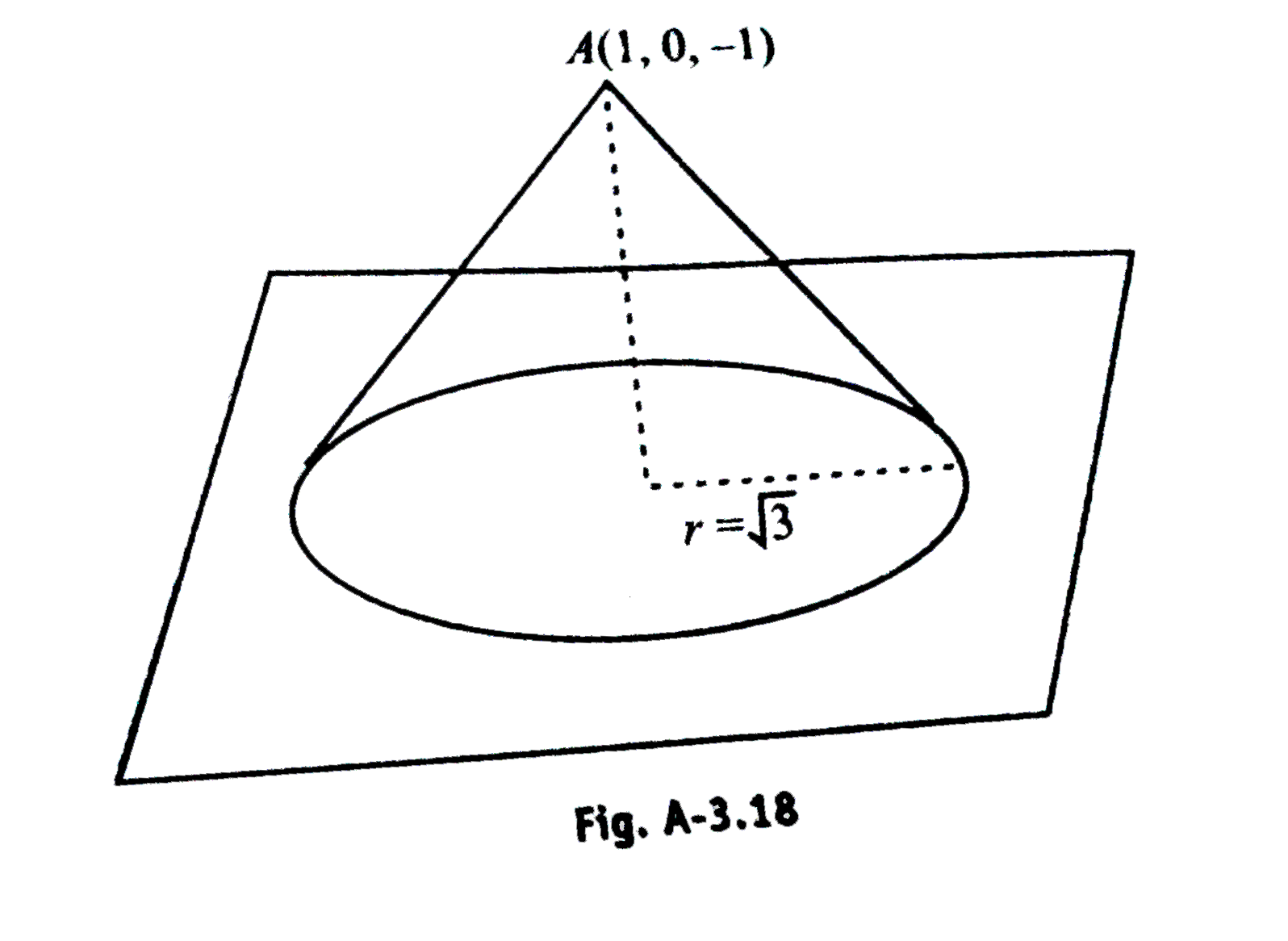A rod of length 2 units whose one end is (1,0,−1) and other end touches the plane x−2y=2Z+4=0, then a. the rod sweeps the figure whose volume is b.πc. d. cubic units. e. the area of the region which the rod traces on the plane is f.g.2πh. i. j. the length of projection of the rod on the plane is k.l.√m.3n.⊙p. q. units. r. the centre of the region which the rod traces on the plane is s.t.(u.v.w.2x.3y.z.,aa.2bb.3cc.dd.,−ee.5ff.3gg.hh.ii.).jj. kk.Solution in Tamil
the rod sweeps the figure whose volume is π cubic units.
the area of the region which the rod traces on the plane is 2π.
the length of projection of the rod on the plane is √3 units.
the centre of the region which the rod traces on the plane is (23,23,−53)
The correct Answer is:b

The rod sweeps out the figure which is a cone.
The distance of point A(1,0,−1) from the plane is
|1−2+4|√9=1 unit
The slant height l of the cone is 2 units.
Then the radius of the base of the cone is
√l2−1=√4−1=√3
Hence, the volume of the cone is
π3(√3)2⋅1=π cubic units
Area of the circle on the plane which the rod traces is 3π.
Also, the centre of the circle is Q(x,y,z). Then
x−11=y−0−2=z+12=−(1−0−2+4)12+(−2)2+22
or Q(x,y,z)≡(23,23,−53).
Topper's Solved these Questions
- BOOK - CENGAGECHAPTER - THREE-DIMENSIONAL GEOMETRY EXERCISE - Exercise (Reasoning Questions)10videos
THREE-DIMENSIONAL GEOMETRY
- BOOK - CENGAGECHAPTER - THREE-DIMENSIONAL GEOMETRY EXERCISE - Exercise (Comprehension)12videos
THREE-DIMENSIONAL GEOMETRY
- BOOK - CENGAGECHAPTER - THREE-DIMENSIONAL GEOMETRY EXERCISE - Exercise (Single)86videos
THREE-DIMENSIONAL GEOMETRY
- BOOK - CENGAGECHAPTER - THREE DIMENSIONAL GEOMETRYEXERCISE - Question Bank12videos
THREE DIMENSIONAL GEOMETRY
- BOOK - CENGAGECHAPTER - TRIGNOMETRIC RATIOS IDENTITIES AND TRIGNOMETRIC EQUATIONSEXERCISE - Question Bank4videos
TRIGNOMETRIC RATIOS IDENTITIES AND TRIGNOMETRIC EQUATIONS
Similar Questions
Statement 1 : Lines →r=ˆi−ˆj+λ(ˆi+ˆj−ˆk)and→r=2ˆi−ˆj+μ(ˆi+ˆj−ˆk) do not intersect.
Statement 2 : Skew lines never intersect.03:34View SolutionGiven four points A(2,1,0),B(1,0,1),C(3,0,1)andD(0,0,2). Point D lies on a line L orthogonal to the plane determined by the points A, B and C.
The equation of the plane ABC is07:07View SolutionIn a three-dimensional xyz space , the equation x2−5x+6=0 represents a. Points b. planes c. curves d. pair of straight lines
01:54View SolutionThe equation of the plane which has the property that the point Q(5,4,5) is the reflection of point P(1,2,3) through that plane, is ax+by+cz=d where a,b,c,d∈N. Find the least value of (a+b+c+d).
07:05View SolutionThe number of solution (s) of the equation
√2+cos2x=(sinx+cosx)∈[−π2,π]06:12View SolutionIf the linear density (mass per unit length) of a rod of length 3m is proportional to x, where x, where x is the distance from one end of the rod, the distance of the centre of gravity of the rod from this end is.
03:59View SolutionA rod of length 2 units whose one ends is (1,0,−1) and other end touches the plane x−2y+2z+4=0, then which statement is false
07:04View SolutionThe thin rod shown below has mases M and length L. A force F acts at one end as shown and the rod is free to rotate about the other end in horizontal plane. Initial angular acceleration of the rod is :
11:16View SolutionA rod of length 2units whose one end is (1,0,−1) and other end touches the plane x−2y+2z+4=0, then
06:44View SolutionM द्रव्यमान तथा L लंबाई की एक छड़ को क्षैतिज तल में उसके एक सिरे पर ऊर्ध्व अक्ष के प्रति कीलकित किया गया है एक क्षैतिज बल F=Mg2 कीलकित सिरे से 5L6 दूरी पर छड़ पर आरोपित किया जाता है । छड़ का कोणीय त्वरण कितना होगा ?
03:31View SolutionA particle is attached to the lower end of a uniform rod which is hinged at its other end as shown in the figure. The minimum speed given to the particle so that the rod performs circular motion in a vertical plane will be ___________ (in m/s)
[length of the rod is l=5m consider masses of both rod and particle to be same, g=10m/s2]
 09:33View Solution
09:33View SolutionA rod of length k slides in a vertical plane, its ends touching the coordinate axes. Prove that the locus of the foot of the perpendicular from the origin to the rod is (x2+y2)3=k2x2y2.
07:55View SolutionA rod of length 2 units whose one ends is (1,0,−1) and other end touches the plane x−2y+2z+4=0, then which statement is false
02:22View SolutionA rod of length k slides in a vertical plane, its ends touching the coordinate axes. Prove that the locus of the foot of the perpendicular from the origin to the rod is (x2+y2)3=k2x2y2.
06:34View Solution2 इकाई लम्बाई की एक छड़ जिसका एक अंतिम सिरा (1,0,-1) तथा दूसरा सिरा एक तल x−2y+2z+4=0 को स्पर्श करता है, तो
03:37View SolutionA rod of length 2 units whose one end is (1,0,−1) and other end touches the plane x−2y+2z+4=0, then
08:09View Solution

